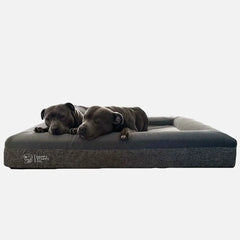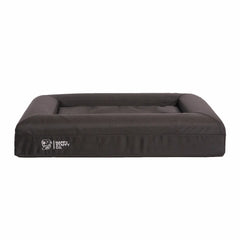Bringing a puppy home is one of the most heartwarming experiences a dog lover can have. Their boundless energy, playful antics, and adorable curiosity make every day an adventure. But, as much as they bring laughter and love into our lives, they also come with challenges—especially when it comes to playtime. Puppies don’t just play for fun; it’s how they learn, grow, and interact with the world around them. The toys we choose for them matter more than most people realise.
Not all puppy toys are created equal. Some are brilliant for teething, mental stimulation, and training, while others pose serious risks that many pet owners overlook. That’s why we’ve put together this guide—not just to help you pick toys, but to ensure your pup has a playtime that’s both fun and beneficial to their well-being.
Key Takeaways:
-
Safe and durable puppy toys are essential during the teething phase. They help soothe sore gums and prevent damage to household items by redirecting chewing behavior appropriately.
-
Choosing the right puppy toys depends on your dog’s breed and personality. Active pups benefit from fetch balls and tug ropes, while sensitive or small breeds may prefer soft plush toys and gentle chews.
-
Supervising playtime ensures that puppy toys remain safe and effective. Regular inspection helps you catch wear and tear before it turns into a choking or ingestion hazard.
-
Rotating puppy toys keeps your dog mentally stimulated and curious. Introducing new textures, sounds, and challenges prevents boredom and encourages healthy cognitive development.
-
Cleanliness and quality matter when selecting and maintaining puppy toys. Stick to non-toxic materials, wash toys frequently, and remove any items that become damaged or frayed.
Understanding the Developmental Needs of Your Puppy

A puppy’s play style changes as they grow. Those first few months are crucial for their physical and mental development, and toys play an enormous role in shaping their behaviour. Here’s what you need to consider at each stage:
The Teething Phase: Chewing Everything in Sight
Teething is a rite of passage for every puppy, and if you’ve ever woken up to shredded shoes or gnawed-on furniture, you know exactly how desperate they are for relief. But here’s something most pet owners don’t realise: not all teething toys are effective. Many rubber toys on the market are too soft to provide proper relief or too hard, risking damage to growing teeth.
Look for durable yet pliable materials like natural rubber or reinforced nylon—tough enough to withstand sharp teeth but flexible enough to soothe sore gums. Bonus points if they have textured surfaces to massage the gums.
Socialisation & Sensory Stimulation: Shaping Their Worldview
Puppies experience the world through their mouths, but that’s not the only way they engage. Toys that introduce different textures, sounds, and movement can help them become more confident and adaptable. Tug toys, crinkly plushies, and toys that mimic prey movement (like those with unpredictable bounces) all encourage natural play behaviours.
Mental Enrichment: More Than Just a Game
Cognitive development is just as important as physical activity. If your pup is constantly finding new ways to get into mischief, they’re likely craving more mental stimulation. Puzzle toys that dispense treats or require problem-solving can turn playtime into a rewarding challenge, preventing boredom-induced behaviours like excessive chewing, digging, or barking.
Matching Toys to Your Puppy’s Personality and Breed

Every puppy has a unique personality, and their breed often influences their play style. Choosing toys that align with your puppy’s natural instincts ensures they stay engaged and fulfilled.
High-Energy Breeds
Puppies like Staffies, Border Collies, and Jack Russells are full of boundless energy and need toys that keep them moving.
-
Flirt Poles mimic the thrill of the chase, helping burn off excess energy.
-
High-bounce fetch balls keep these active pups engaged and physically stimulated.
-
Rope tug toys provide a fantastic outlet for strength-building and bonding play.
Gentle or Lapdog Breeds
Cavaliers, Bichons, and other small breeds often prefer gentler, comfort-driven play.
-
Soft plush toys with squeakers offer comfort and light play.
-
Mini puzzle toys encourage mental engagement without being too demanding.
-
Gentle rubber chew toys help with teething without overwhelming their small jaws.
Power Chewers
Staffies, Rottweilers, and Bulldogs are notorious for their strong jaws and relentless chewing.
-
Reinforced rubber toys withstand aggressive chewing.
-
Tough nylon chew toys provide long-lasting relief and engagement.
-
Indestructible treat-dispensing toys keep them occupied for longer periods.
Anxious or Sensitive Pups
Some puppies, especially rescues or those adjusting to new homes, need extra reassurance.
-
Scented plush toys with their owner’s smell can provide comfort.
-
Heartbeat snuggle toys mimic a mother’s heartbeat for relaxation.
-
Slow-release treat toys help distract and calm nervous pups.
Choosing the Right Toys: More Than Just Size and Material
We all know the basics—choose toys that are appropriately sized and made from non-toxic materials. But let’s go deeper. What makes a toy truly safe and engaging for your pup?
Durability Meets Play Style
Not every puppy is a gentle chewer. Some have a knack for destruction, tearing through plushies in seconds and ripping apart cheap rubber toys with ease. When choosing toys, consider your puppy’s bite strength and play habits. Reinforced stitching, double-layered fabric, and industrial-grade rubber aren’t just marketing gimmicks—they’re game-changers for power chewers.
Hidden Dangers Most Owners Overlook
-
Squeakers: Sure, they’re fun, but for some puppies, they trigger an instinct to “kill the prey” by tearing out the squeaker. If swallowed, this can lead to choking or intestinal blockages. Opt for toys with encased or self-sealing squeakers that prevent accidental ingestion.
-
Rope Toys: While great for interactive play, poorly made rope toys can fray easily. If swallowed, the fibres can cause serious digestive issues. Always supervise play with rope toys and discard them at the first sign of unraveling.
-
Painted or Dyed Toys: Some manufacturers use toxic dyes and coatings. Choose toys labelled as BPA-free, phthalate-free, and food-grade whenever possible.
The Must-Have Toy Categories for Every Puppy

We believe in variety when it comes to playtime. Here’s our go-to list of toy types that cover all the bases:
1. Teething Toys: Soothing Those Sore Gums
-
Natural rubber chew toys (look for grooves and ridges that provide extra relief)
-
Freezable toys (cold surfaces numb the gums and reduce inflammation)
-
Edible chew toys made from digestible, natural materials
2. Interactive Play Toys: Bonding and Exercise
-
Tug toys with reinforced stitching
-
Fetch balls that bounce erratically to keep your pup engaged
-
Flirt poles (great for activating prey drive and controlled energy release)
3. Puzzle and Treat-Dispensing Toys: Brain Games for Smart Pups
-
Adjustable difficulty treat puzzles
-
Hide-and-seek plush toys
-
Slow feeder bowls with hidden compartments
4. Comfort Toys: More Than Just Cuddly Plushies
-
Scented toys that carry your smell for separation anxiety relief
-
Heatable plush toys that mimic warmth for lonely nights
-
Weighted or heartbeat toys for crate training and soothing nervous pups
Toys to Avoid at All Costs
We’ve seen it time and time again—well-meaning owners buying toys that seem harmless but turn out to be dangerous. Here are some no-go options:
-
Plastic or Vinyl Chew Toys: These can splinter into sharp pieces, causing mouth injuries or digestive damage.
-
Cheap Plush Toys with Weak Stitching: If your pup loves de-stuffing toys, opt for stuffing-free plushies to avoid ingestion risks.
-
Real Bones and Antlers: While natural, they can be too hard for puppies, leading to broken teeth.
How to Introduce New Toys to Your Puppy

Introducing new toys the right way ensures your puppy gets the most enjoyment and engagement from them. Here’s how to do it effectively:
-
Rotate Between Old and New: Puppies can get overwhelmed with too many toys at once. Introduce one or two at a time and swap them out periodically to maintain interest.
-
Encourage Positive Associations: If your pup is hesitant about a new toy, try rubbing it with their favourite blanket or using treats to create excitement.
-
Supervise the First Few Play Sessions: This allows you to observe how they interact with the toy and ensure it’s safe for their chewing habits.
-
Incorporate Training into Playtime: Using toys as rewards during training sessions helps reinforce positive behaviour and keeps your puppy engaged.
Maintenance & Monitoring: Keeping Playtime Safe
Even the best toys don’t last forever. Here’s how to make sure your pup’s toys stay in top shape:
-
Inspect Regularly: Look for signs of wear, especially small tears or pieces breaking off.
-
Wash Frequently: Bacteria builds up fast! Rubber and silicone toys can be cleaned with mild soap and warm water, while plush toys should be machine-washed.
-
Rotate Toys: Keep your pup interested by switching out their toys every few days.
Investing in Play the Right Way
We get it—there are hundreds of puppy toys on the market, and choosing the right ones can feel overwhelming. But at the end of the day, what matters most is that your pup’s toys are safe, stimulating, and built to last. Whether it’s teething relief, mental enrichment, or interactive play, the right toys can set your puppy up for a lifetime of healthy habits and happy memories.
At Happy Staffy Co., we’re not just passionate about great toys—we’re passionate about great dogs. We know every wag, zoomie, and playful bark is a sign of a pup that’s thriving. That’s why we’ll always be here to help you make the best choices for your four-legged mate. After all, when it comes to our dogs, only the best will do.



